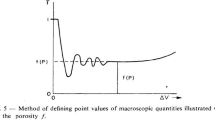Abstract
A variety of contemplative demonstrations concerning intermediate-to-large length scale capillary fluidic phenomena were made possible by the brief weightless environment of a drop tower (Wollman and Weislogel in Exp Fluids 54(4):1, 2013). In that work, capillarity-driven flows leading to unique spontaneous droplet ejections, bubble ingestions, and multiphase flows were introduced and discussed. Such efforts are continued herein. The spontaneous droplet ejection phenomena (auto-ejection) is reviewed and demonstrated on earth as well as aboard the International Space Station. This technique is then applied to novel low-g droplet combustion where soot tube structures are created in the wakes of burning drops. A variety of new tests are presented that routinely demonstrate ‘puddle jumping,’ a process defined as the spontaneous recoil and ejection of large liquid drops from hydrophobic surfaces following the step reduction in ‘gravity’ characteristic of most drop towers. The inverse problem of ‘bubble jumping’ is also demonstrated for the case of hydrophilic surfaces. A variety of puddle jump demonstrations are presented in summary as a means of suggesting the further exploitation of drop towers to study such large length scale capillary phenomena.




























Similar content being viewed by others
References
Chunhui L (1993) Microgravity drop tower facilities. Struct Environ Eng 4:227
Corning D (1998) Product information Dow Corning 200 fluid. http://webservice.oxygenekatalog.dk/getDoc.aspx?DocID=11996. Ref. no. 22-0069N-01
Dietrich DL, Nayagam V, Hicks MC, Ferkul PV, Dryer FL, Farouk T, Shaw BD, Suh HK, Choi MY, Liu YC et al (2014) Droplet combustion experiments aboard the international space station. Microgravity Sci Technol. doi:10.1007/s12217-014-9372-2
Dittus H (1991) Drop tower ‘Bremen’: a weightlessness laboratory on earth. Endeavour 15(2):72
Kirko I, Dobychin E, Popov V (1970) Phenomenon of the capillary. Sov Phys Dokl 15:442
Leidenfrost JG (1756) De aquae communis nonnullis qualitatibus tractatus. Ovenius, Duisburg
Lekan J, Neumann E, Sotos R (1993) Capabilities and constraints of NASA’s ground-based reduced gravity facilities In: The second international microgravity combustion workshop (SEE N93-20178 07-29), vol 1, pp 45–60
Marchese A, Dryer F, Colantonio R, Nayagam V (1996) Microgravity combustion of methanol and methanol/water droplets: Drop tower experiments and model predictions. In: Symposium (international) on combustion, vol 26. Elsevier, pp 1209–1217. http://www.sciencedirect.com/science/article/pii/S0082078496803377
McGraw JD, Li J, Tran DL, Shi AC, Dalnoki-Veress K (2010) Plateau-Rayleigh instability in a torus: formation and breakup of a polymer ring. Soft Matter 6:1258. doi:10.1039/B919630G
Mehrabian H, Feng JJ (2014) Auto-ejection of liquid drops from capillary tubes. J Fluid Mech 752:670
Meseguer J, Sanz-Andrés A, Pérez-Grande I, Pindado S, Franchini S, Alonso G (2014) Surface tension and microgravity. Eur J Phys 35(5):055010. http://stacks.iop.org/0143-0807/35/i=5/a=055010
Moláček J, Bush JW (2012) A quasi-static model of drop impact. Phys Fluids (1994-present) 24(12):127103. http://scitation.aip.org/content/aip/journal/pof2/24/12/10.1063/1.4771607
Nguyen TD, Fuentes-Cabrera M, Fowlkes JD, Diez JA, González AG, Kondic L, Rack PD (2012) Competition between collapse and breakup in nanometer-sized thin rings using molecular dynamics and continuum modeling. Langmuir 28(39):13960. doi:10.1021/la303093f
Pairam E, Fernández-Nieves A (2009) Generation and stability of toroidal droplets in a viscous liquid. Phys Rev Lett 102(23):234501. doi:10.1103/PhysRevLett.102.234501
Richard D, Clanet C, Quéré D (2002) Surface phenomena: contact time of a bouncing drop. Nature 417(6891):811. http://www.nature.com/nature/journal/v417/n6891/abs/417811a.html
Snyder TJ, Andrews M, Weislogel M, Moeck P, Stone-Sundberg J, Birkes D, Hoffert MP, Lindeman A, Morrill J, Fercak O et al (2014) 3D systems’ technology overview and new applications in manufacturing, engineering, science, and education. 3D Print Addit Manuf 1(3):169
Steinberg T (2008) Reduced gravity testing and research capabilities at new 2.0 second drop tower. J Achiev Mater Manuf Eng 31(2):822
Suñol F, González-Cinca R (2011) Droplet collisions after liquid jet breakup in microgravity conditions. J Phys Conf Ser 327(1):012026. http://stacks.iop.org/1742-6596/327/i=1/a=012026
Texier BD, Piroird K, Quéré D, Clanet C (2013) Inertial collapse of liquid rings. J Fluid Mech 717:R3. http://journals.cambridge.org/abstract_S0022112013000153
Vitz E (1990) Magic sand: modeling the hydrophobic effect and reversed-phase liquid chromatography. J Chem Educ 67(6):512. doi:10.1021/ed067p512
Weislogel MM (2012) Recent capillary fluid research relevant to spacecraft system design. In: 7th International symposium on two-phase systems for ground and space applications. Beijing, China, 17–21 Sept 2012
White FM, Corfield I (2006) Viscous fluid flow, vol 3. McGraw-Hill, New York
Wollman A (2012) Capillarity-driven droplet ejection. Master’s thesis, Portland State University. http://archives.pdx.edu/ds/psu/8243
Wollman A, Weislogel M (2013) New investigations in capillary fluidics using a drop tower. Exp Fluids 54(4):1. doi:10.1007/s00348-013-1499-1
Yao Z, Bowick M (2011) The shrinking instability of toroidal liquid droplets in the Stokes flow regime. Eur Phys J E 34(3):32. doi:10.1140/epje/i2011-11032-9
Zhang L, Li ZD, Zhao JF (2014) Rebound of liquid droplets caused by sudden decrease of gravity. Interfacial Phenom Heat Transf 2(1):41
Acknowledgments
This work was in part completed under NASA cooperative agreement NNX09AP66A and NASA/Oregon Space Grant Consortium grant NNX10AK68H, the latter of which was used in part to support A. Wollman and B. Wiles. We also acknowledge the 3D print support of the Xerox Corporation and 3-D Systems.
Author information
Authors and Affiliations
Corresponding author
Additional information
NASA cooperative agreement NNX09AP66A and NASA/Oregon Space Grant Consortium grant NNX10AK68H.
Rights and permissions
About this article
Cite this article
Wollman, A., Weislogel, M., Wiles, B. et al. More investigations in capillary fluidics using a drop tower. Exp Fluids 57, 57 (2016). https://doi.org/10.1007/s00348-016-2138-4
Received:
Revised:
Accepted:
Published:
DOI: https://doi.org/10.1007/s00348-016-2138-4




